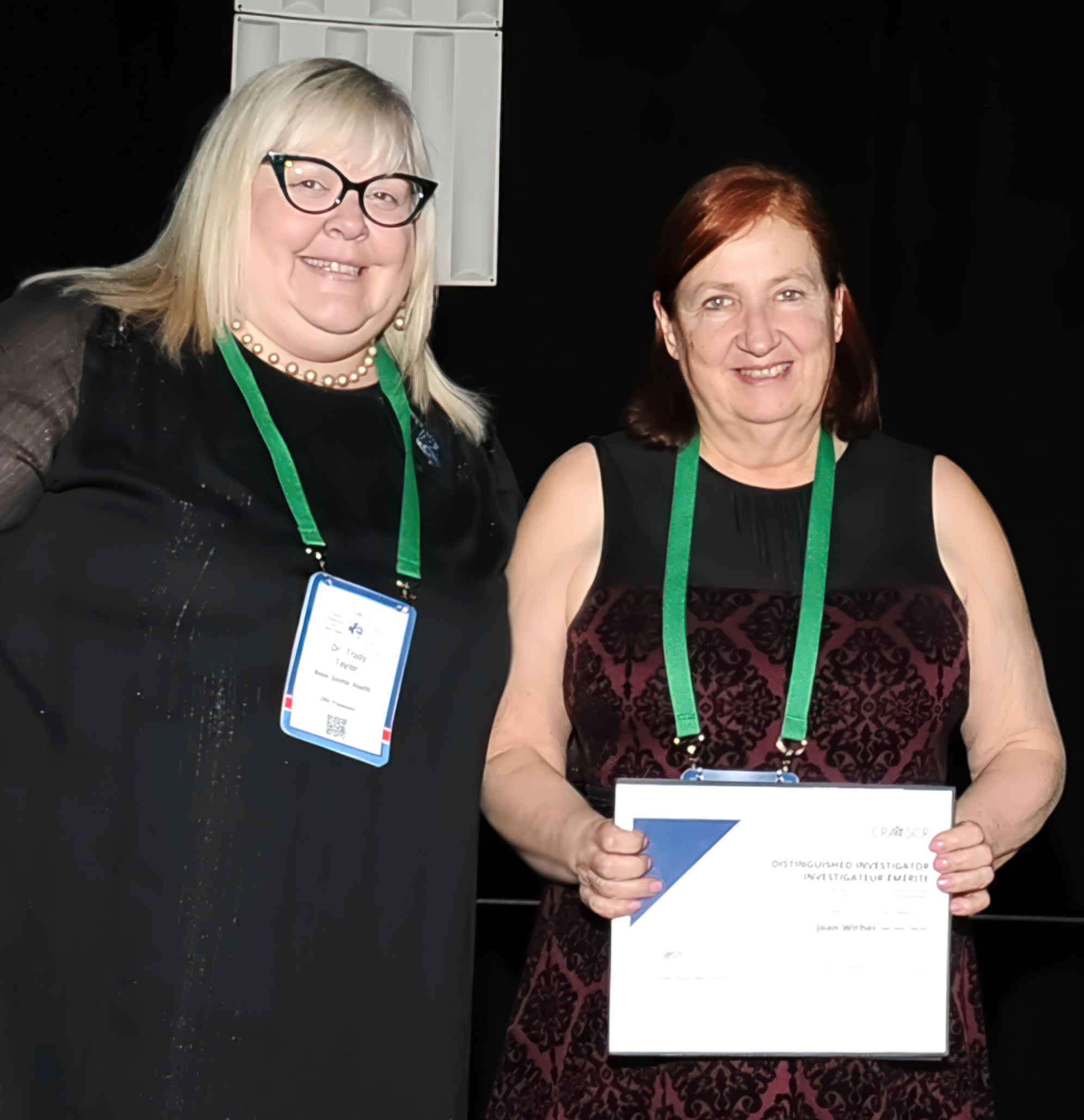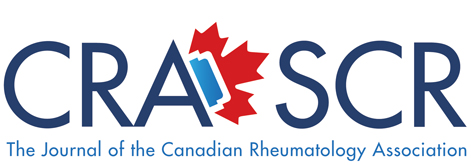Summer 2025 (Volume 35, Number 2)
The CRA’s 2025 Distinguished
Investigator:
Dr. Joan Wither
Download PDF

What was your first thought when you learned that you would receive this award?
I was pleased and honoured.
You are a professor in the Departments of Medicine and Immunology at the University of Toronto and a Senior Scientist in the Schroeder Arthritis Institute at the Krembil Research Institute. You are also a staff rheumatologist at University Health Network, where you are a Director of the STAT (urgent assessment) and Early Autoimmune Rheumatic Disease Clinics.
Why did you become a rheumatologist? What or who influenced you along the way to do so?
When I was a medical student at the University of Alberta, I first learned about immunology (which was in its infancy) and became interested in the immune system. This led me to do an elective in immunology at the National Institutes of Health. There we did rotations on the clinical wards, one of which was the rheumatology ward where I remember seeing lupus patients, and another of which was the immunology ward run by Tony Fauci, where he was studying patients with granulomatous diseases including GPA. As part of that elective, we had lectures from several world-renowned immunologists, including some who later received Nobel Prizes, and I became fascinated with the immune abnormalities that produce disease, in particular rheumatic disease. When I moved to Toronto to do my internal medicine residency, one of my first electives was rheumatology, where unfortunately I saw virtually no patients with systemic disease, as they mostly suffered from osteoarthritis and soft tissue rheumatism. As a result, I almost changed my mind and ended up in gastroenterology, but ultimately became persuaded to apply to rheumatology (which I have never regretted!).

Dr. Joan Wither receiving her award from CRA President
Dr. Trudy Taylor at the CRA Annual Scientific Meeting in Calgary, which took place in February 2025.
What do you believe are the qualities of a distinguished investigator and rheumatologist?
An inquisitive nature—always wanting to know why or how something works, and a passion for trying to solve puzzles. Perseverance and a thick skin—when you are doing experimental work, most things do not work the first time and require trouble-shooting. Also, there is lots of rejection! Grant applications are more likely to be rejected than not. Manuscript submissions are often rejected at first, or at the very least have to be revised. This definitely keeps you humble.
Your translational research program focuses upon the Systemic Autoimmune Rheumatic Diseases (SARDs), including systemic lupus erythematosus, Sjogren’s disease, and systemic sclerosis. What are the goals of the program?
SARDs often have irreversible organ damage at diagnosis. Although anti-nuclear antibodies (ANAs) are present years before disease onset, they cannot be used to accurately predict disease development because they are also found in many healthy individuals, the majority of whom will not progress to SARDs. Early treatment could prevent much of the organ damage present when SARDs are diagnosed. Currently there is insufficient knowledge regarding the immunological changes that distinguish ANA+ individuals from those with SARDs, and those who will progress from those who will not, to identify individuals at high risk for disease development and determine which immune pathways should be targeted. (Our goals are to address these questions and fill this knowledge gap).
To address these questions, I established the Early Autoimmune Rheumatic Disease Clinic, in which ANA+ individuals who lack or have insufficient clinical criteria for a SARD diagnosis (ANA+NS) are followed longitudinally, with blood drawn for bio-banking at baseline and yearly thereafter (or earlier if new symptoms develop). To date, ~400 subjects have been recruited, of which approximately two thirds are ANA+ without a SARD diagnosis, with 15% of these individuals demonstrating clinical progression upon follow-up. Using this unique cohort, my laboratory has made substantial inroads into the understanding of the immunologic processes that lead to development of a positive ANA, promote progression, and distinguish ANA+NS from patients with early untreated SARDs. Specifically, we have shown that many of the immunologic features thought to be specific for SARDs, such as increased proportions of antibody secreting cells and the T cells that support them, are also seen in ANA+NS, suggesting that they are associated with production of autoantibodies. In ANA+NS, symptomatic autoimmunity appears to be held in check by an expansion of T regulatory cells, whereas in SARD this expansion becomes attenuated and is accompanied by increases in pro-inflammatory T (Th2 and Th17) and innate (CD14+mDC and intermediate monocytes) immune subsets.
Your laboratory has produced a large body of work dissecting the genetic basis for disease in lupus mouse strains that provided a conceptual basis for our understanding of human SLE pathogenesis. You have also contributed to international GWAS and Immunochip efforts leading to identification of novel genetic risk loci in SLE. More recently, your work has provided insight into how interferons disrupt immune function to promote development of SARD and affect disease outcomes in SLE. Through creation of a novel cohort of longitudinally followed individuals with anti-nuclear antibodies, you have identified biomarkers associated with an increased risk of SARD development and begun to elucidate the immunologic events that result in the transition from asymptomatic autoimmunity to disease. Finally, your research has led to identification of novel biomarkers allowing stratification of lupus nephritis patients with regard to treatment responses and long-term renal outcomes.
Can you tell us more about your research in SLE and its major findings?
Defining the role of Interferons (IFNs) in SARDs. Elevated levels of IFN-induced gene expression are a hallmark of SARDs, in particular SLE, and my laboratory has provided several key insights into the role of IFNs in these conditions. We were the first to conclusively demonstrate that the levels of IFN-induced gene expression in the blood are relatively stable despite fluctuations in disease activity in SLE and consequently cannot be used to predict impending flares. Instead, we showed that high levels of IFN-induced gene expression predict a more severe disease course requiring more aggressive therapy. We have also explored the immune mechanisms by which IFN exacerbates disease. We have shown that serum levels of IFN in SLE are sufficient to disturb B cell function, leading to enhanced B cell activation following B cell receptor engagement. Using a novel mouse model with a B cell repertoire enriched for dsDNA reactivity that is injected with an IFNα-producing adenovirus, together with a B cell specific knockout for the IFNα receptor, we have shown that IFN acts directly on B cells to disturb their function, overcoming multiple mechanisms of B cell tolerance, resulting in autoantibody production. Collectively, these studies indicate the importance of IFN as a drug target in SLE, which is supported by the recent successful trials of anifrolumab, an anti-IFN Type 1 receptor monoclonal antibody, in SLE.
Development of tools to improve disease outcomes in Lupus Nephritis. As co-I of LuNNET, a collaboration between rheumatologists, nephrologists, and pathologists to investigate renal disease in SLE, I was responsible for creating an extensive biobank of DNA, serum, RNA, and urine samples from longitudinally followed SLE patients with and without nephritis, a highlight of which was approximately 100 patients who had their baseline sample at the time of a renal biopsy. This invaluable resource has attracted CIHR, industry and US public (Alliance for Lupus Research) funding, and led to the identification of novel molecular, serologic, and urinary biomarkers for nephritis, resulting in a patent application. We recently demonstrated the utility of these urinary biomarkers in monitoring and predicting treatment responses and are now working towards developing this into a clinical test. In ongoing experiments, we are seeking to stratify patients with regard to long-term renal outcomes at the time of renal flare. To this end, we are examining the ability of IFN-induced gene expression levels in renal biopsies (measured by imaging mass cytometry using our IFN-induced protein specific panel) and various serologic markers (NETs, IFNα) to predict treatment responses. This will allow intensification of therapy in patients at risk of a poor prognosis, improving long-term outcomes.
Examination of the immune mechanisms that lead to flares of disease activity in SLE. In the majority of patients, SLE is a relapsing and remitting disease. Currently, the immune mechanisms that promote/trigger flares and, conversely, maintain disease quiescence are unknown. To address this question, SLE patients with a recent flare (< 1 month) or prolonged disease quiescence (at least 1 year) were recruited, and their blood obtained at baseline and every 6 months for at least 2 years. Using flow cytometry to perform extensive profiling of peripheral blood immune subsets, the immune changes in SLE patients were found to be segregated into five clusters that variably contained active and quiescent SLE patients and that had distinct clinical phenotypes. Notably, patients characterized by increased T peripheral helper, activated B, and age-associated B cells were the most likely to be flaring at baseline, as well as the most likely to remain active or flare over the subsequent year if they acquired or retained this phenotype at follow-up. These findings re-iterate the importance of controlling B cell activation in the management of lupus, which has been reinforced by the results of CD19 CAR-T cell trials, where effective depletion of B cells has led to prolonged remissions.
Are there other areas of interest you would like to investigate in the future?
I am very interested in what triggers flares of disease and whether the type of trigger plays a role in defining disease heterogeneity. I am also interested in whether we can manipulate the immune system to restore tolerance and prevent disease.
What are some of your other passions outside of rheumatology and medical education?
Golf and fitness. I golf 2-3 times a week in the summer. I also attend fitness classes twice a week all year and do additional cardio/fitness activities myself another 2-3 times a week.
Do you find there is synergy between your research and your clinical work with patients? If so, can you provide any examples?
Yes, there is synergy. Not uncommonly, research questions arise from patient management issues or questions raised by patients. For example, we did a study on whether fatigue in ANA+ individuals was associated with elevated levels of inflammatory markers and predicted development of disease, because I was often asked this question by patients. We showed that this was not the case, and thus I am able to tell my patients that we studied this and showed that this was not associated with an increased risk of progression. Our studies of urinary and blood biomarkers came out of the desire to improve management of lupus nephritis by identifying patients early who are not responding to conventional treatment, so that their treatment can be modified to improve outcomes.
How many cups of coffee or tea does it take to make a productive day?
I am decaffeinated so this is not a big thing for me.
Joan Wither, MD, FRCPC, PhD
Rheumatologist,
Department of Immunology,
Faculty of Medicine, University of Toronto
Schroeder Arthritis Institute,
Krembil Research Institute,
University Health Network
Toronto, Ontario
|
